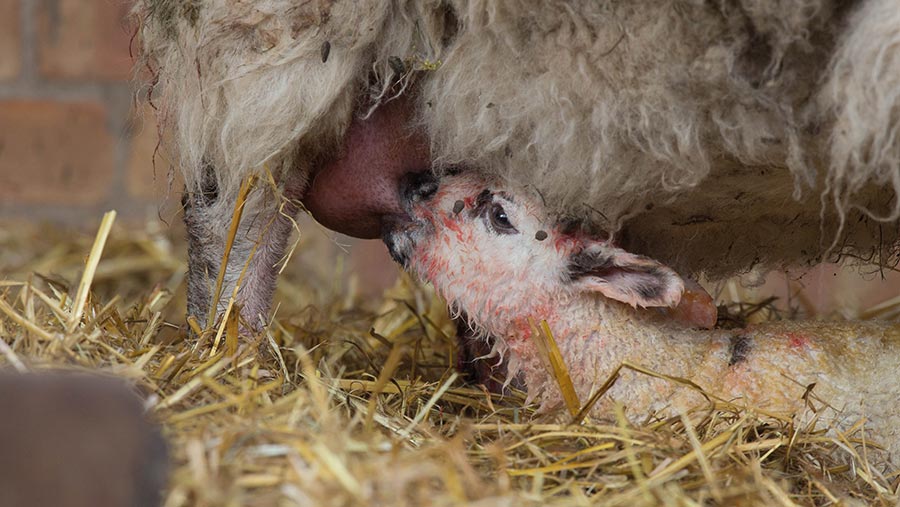Watery mouth poses risk at lambing as antibiotic withdrawn - FarmersWeekly
 © Tim Scrivener
© Tim Scrivener Vets have warned sheep producers to devise a plan to combat watery mouth after the withdrawal of a vital antimicrobial treatment.
Sheep vet and former Sheep Veterinary Society (SVS) president Fiona Lovatt has described the situation as serious.
Watery mouth is caused by an E coli bacterium harboured in the surrounding environment, Ms Lovatt explained.
See also: 8 ways to prepare for a busy lambing season
Newborn lambs have no immunity and bacteria spread rapidly in the gut causing illness and mortality, usually within the first few days after lambing.
In the past, flocks have relied on prevention via the spectinomycin antimicrobial Spectam Scourhalt, produced by Ceva Animal Health.
Spectam has been the only oral product licensed to combat the disease prophylactically, and 6m doses were sold in the UK last year.
However, manufacturing difficulties, set against a backdrop of steadily declining sales, led to Ceva ceasing production in 2021.
Lack of alternatives
Ms Lovatt said there is no other oral solution like Spectam that can be given to every newborn lamb as a preventative measure.
This leaves the sheep sector facing a fast-approaching lambing season without a similar authorised treatment.
Instead, she said farmers should consult vets, who may be able to prescribe injectable treatments or alternative oral products used in the cattle and pig sectors.
These are powders that need to be diluted for treatment, posing additional difficulties over accurate rates, water quality and safe disposal of any excess.
It may be possible for vets to obtain a spectinomycin product licensed for young piglets in the US, but this requires a special import certificate.
However, these treatments cannot be used as a preventative measure across the whole flock.
"They must only be used on carefully targeted, high-risk individual animals, such as low birthweight lambs and triplets as part of an agreed, proactive health plan," Ms Lovatt said.
"It means that flock managers must step up preventative measures ahead of this year's lambing season."
Top tips to cut risk of watery mouth
Fiona Lovatt and AHDB Beef and Lamb suggest these preventative measures to reduce the risk of watery mouth.
You can also read more Farmers Weekly advice: 5 top tips to prevent watery mouth in lambs
1. Colostrum management
Nutrition and body condition score are key to colostrum production and quality, lamb vigour and reduced difficulties at lambing. Good-quality colostrum is vital to provide immunity in newborn lambs.
- A lamb needs about 50ml/kg liveweight immediately after birth, and about 200ml/kg in the first 24 hours
- Quality is crucial and can be assessed using a Brix refractometer. This costs about £30
- Colostrum may need supplementing when quality is low and for twins and triplet lambs, lambs following a difficult birth and lambs from ill ewes
- Consider using a pump to milk ewes which have lost their lambs or with strong singles – a milking machine can make a fiddly job very straightforward. An Udderly EZ costs about £130
- If it is not possible to harvest from a ewe, use cow colostrum. If neither is available, use a powdered colostrum
- Ensure every member of staff is trained to carry out the farm's colostrum protocol
- Avoid tail docking and castration on the first day of life as these tasks can put lambs off suckling colostrum.
2. Hygiene environment
Watery mouth often emerges in late lambing when wet, dirty bedding allows bacteria to multiply.
- Keep pens well-bedded and change regularly with clean straw
- If thorough cleaning is not possible at times of peak activity, ensure afterbirth is removed from lambing pens. Apply a good depth of straw to create a clean, dry barrier to the underlying bedding
- Muck out and disinfect mothering-up pens between each use
- Provide fresh air and ventilation to remove moisture from the environment
- Ensure equipment is clean and disinfected. Use separate stomach tubes for already infected lambs and healthy lambs.
3. Care of sick lambs
- Isolate sick lambs and the ewe away from the healthy flock.
Comments
Post a Comment